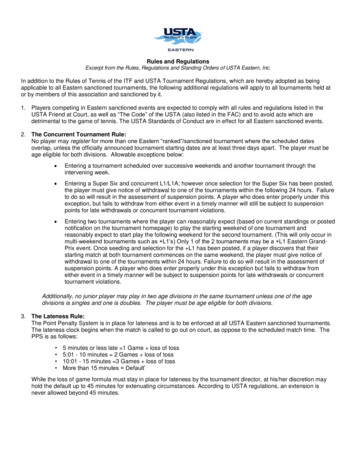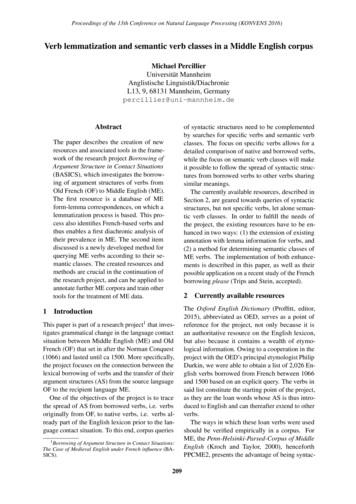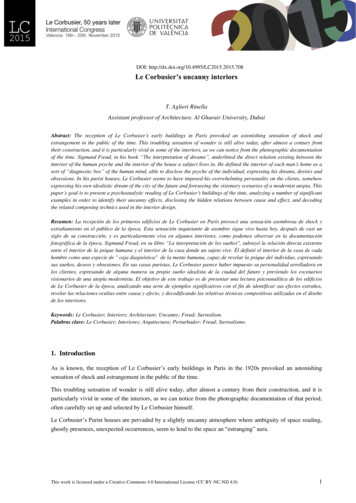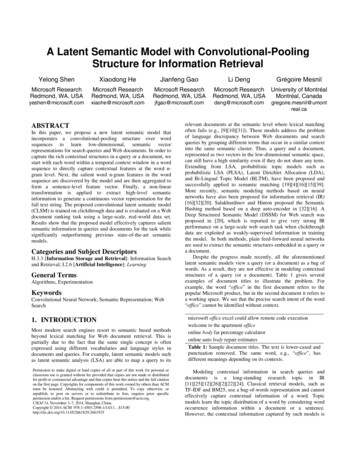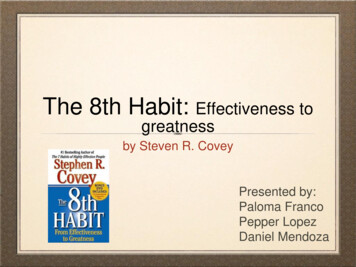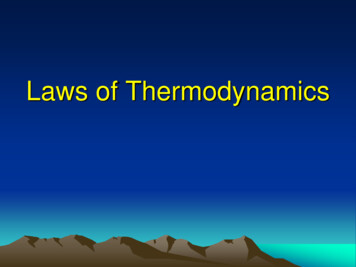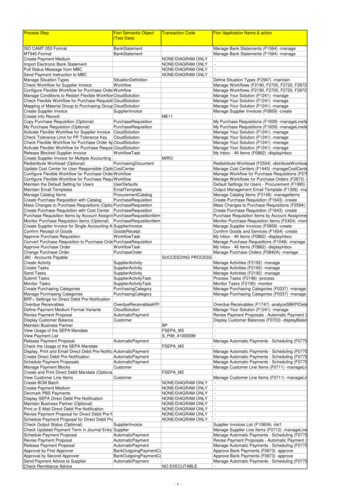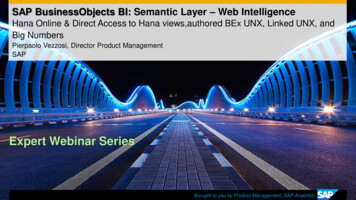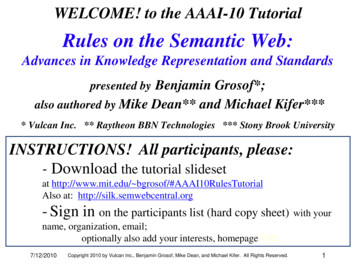
Transcription
WELCOME! to the AAAI-10 TutorialRules on the Semantic Web:Advances in Knowledge Representation and Standardspresented by Benjamin Grosof*;also authored by Mike Dean** and Michael Kifer**** Vulcan Inc. ** Raytheon BBN Technologies *** Stony Brook UniversityINSTRUCTIONS! All participants, please:- Download the tutorial slidesetat http://www.mit.edu/ bgrosof/#AAAI10RulesTutorialAlso at: http://silk.semwebcentral.org- Sign in on the participants list (hard copy sheet) with yourname, organization, email;optionally also add your interests, homepage URL7/12/2010Copyright 2010 by Vulcan Inc., Benjamin Grosof, Mike Dean, and Michael Kifer. All Rights Reserved.1
Top-Level Outline of TutorialA. Introduction, Overview, and UsesB. Concepts and FoundationsC. Conclusions and Directions Appendix: References and ResourcesBackground Assumed: basic knowledge of first-order logic, relationaldatabases, XML, RDF7/12/2010Copyright 2010 by Vulcan Inc., Benjamin Grosof, Mike Dean, and Michael Kifer. All Rights Reserved.2
Outline of Part A. Intro & Uses1.2.3.Overview of tutorial, and get acquaintedWhat are: Rules on the Web, Semantic Rules/Web/TechUses and Kinds of rules Commercial, web. Current, envisioned. Requirements. Business value, IT lifecycle. Strategic roadmapping of future adoption4. Example Use Cases E-commerce: pricing, ordering policies, contracts E-science: ecological process, mechanics context Trust: compliance, policies, e.g. financial services Info integration, ontology mapping, business reporting Processes: policy-based workflow, causal action effects,Semantic Web ServicesNB: (2.)-(4.) are interleaved.7/12/2010Copyright 2010 by Vulcan Inc., Benjamin Grosof, Mike Dean, and Michael Kifer. All Rights Reserved.3
Outline of Part B. Concepts & Foundations1.2.3.4.5.6.7.8.9.Overview of Logical Knowledge Representations Logic Programs (LP) and its relationship to First Order Logic (FOL) Rule-based Ontologies: Description Logic, Description LPSILK‟s Hyper LP: Putting it all togetherBasics: Horn Case; FunctionsF-Logic, Frame Syntax, Object Oriented StyleHiLog, Higher-Order Syntax, Reification, Meta-ReasoningW3C Rule Interchange Format (RIF): Dialects, Framework Rules in W3C Web Ontology Language (OWL-RL); via RIFNonmonotonic LP: Defaults, Negation, Priorities, FOL Interchange Semantics for Default Negation Courteous LP, Argumentation Theories Hyper Rules, FOL-Soundness, Remedying FOL‟s FragilityProcedural Attachments to Actions, Queries, Built-ins, and Events Production/Situated LP, Production RulesAdditional Features: Integrity Constraints, Inheritance, Lloyd-Topor,Equality, Skolemization, Aggregation, Datatypes, “Constraints”7/12/2010Copyright 2010 by Vulcan Inc., Benjamin Grosof, Mike Dean, and Michael Kifer. All Rights Reserved.4
Outline of Part C. Conclusions & Directions1. More about Tools2. incl. SILK3. Conclusions4. Directions for Future researchAppendix: References and Resources(General Discussion)7/12/2010Copyright 2010 by Vulcan Inc., Benjamin Grosof, Mike Dean, and Michael Kifer. All Rights Reserved.5
Rough Schedule, Overall 14:00-14:30 Part A: Intro & Uses 14:30-15:45 Part B: Concepts & Foundations 15:45-16:15 Coffee Break 16:15-17:40 Part B, continued: Concepts & Foundations 17:40-18:00 Part C: Conclusions & Directions7/12/2010Copyright 2010 by Vulcan Inc., Benjamin Grosof, Mike Dean, and Michael Kifer. All Rights Reserved.6
PART A. SLIDESFOLLOW7/12/2010Copyright 2010 by Vulcan Inc., Benjamin Grosof, Mike Dean, and Michael Kifer. All Rights Reserved.7
Outline of Part A. Intro & Uses1.2.3.Overview of tutorial, and get acquaintedWhat are: Rules on the Web, Semantic Rules/Web/TechUses and Kinds of rules Commercial, web. Current, envisioned. Requirements. Business value, IT lifecycle. Strategic roadmapping of future adoption4. Example Use Cases E-commerce: pricing, ordering policies, contracts E-science: ecological process, mechanics context Trust: compliance, policies, e.g. financial services Info integration, ontology mapping, business reporting Processes: policy-based workflow, causal action effects,Semantic Web ServicesNB: (2.)-(4.) are interleaved.7/12/2010Copyright 2010 by Vulcan Inc., Benjamin Grosof, Mike Dean, and Michael Kifer. All Rights Reserved.8
Learning Goals for Tutorial1. Overview of current state of logical KR theory,applications, languages, standards, tools/systems,market2. Relationship to Web and Semantic Tech, overall3. Introduction to the research issues7/12/2010Copyright 2010 by Vulcan Inc., Benjamin Grosof, Mike Dean, and Michael Kifer. All Rights Reserved.9
“Semantic” Technology “Semantic” in “semantic web” and “semanticrules” means:– 1. Knowledge-based and – 2. Having meaning independent of algorithm andimplementation– Equipped with an interoperable conceptual abstraction based on declarative knowledge representation (KR) Shared principles of what inferences are sanctionedfrom a given set of premisesCopyright 2010 by Vulcan Inc., Benjamin Grosof, Mike Dean, and Michael Kifer. All Rights Reserved.10
What are Rules on the Web Convergence of three streams is well along the way1.Using Web for interchange of rules, even pre-Web legacy kinds 2.XML syntax for rules. Transcend organizational silos.Rules working in Web context, using: 3.Web data, schemas, ontologies; Web services, queries, databasesRules using semantic knowledge representation (KR) Semantics are required for effective sharing of knowledge and tools Web as scope for rule-based structured knowledge–––Enrich the Web as a knowledge platform – public and intranetsCollaborative knowledge acquisition (KA), e.g., Wiki‟sWeb-located knowledge bases (KBs) and KR services Semantic rules on the Web–Standardization is a key activity currently. 1st wave just completed.7/12/2010Copyright 2010 by Vulcan Inc., Benjamin Grosof, Mike Dean, and Michael Kifer. All Rights Reserved.11
Semantic Web in context of Webhazy still: Semantic Web ServicesSemantic Web techniquesWeb Services techniquesAPIs on WebAutomated KnowledgeBases(WSDL/SOAP, REST)Rules (RuleML, RIF)Ontologies (OWL, RDFS)XMLDatabases (SQL, SPARQL)Two interwoven aspects: Program: Web Services Data: Semantic WebFirst GenerationWeb7/12/2010Copyright 2010 by Vulcan Inc., Benjamin Grosof, Mike Dean, and Michael Kifer. All Rights Reserved.12
Semantic Web: concept, approach, pieces knowledge Shared semantics when interchanging data Knowledge Representation (cf. AI, DB) as approach to semantics– Standardize KR syntax, with KR theory/techniques as backing Web-exposed Databases: relational and XML/RDF data/queries– Challenge: share database schemas via meta-data– RDF “Resource Description Framework” W3C standard Ontology formally defined vocabulary– OWL: “Web Ontology Language” W3C standard Taxonomic class/property hierarchy, property-value restrictions, decidable subset of FOL– Ex.: Lions are a subcategory within felines– Ex.: Every health care visit has a required copayment amountRules if-then logical implications, facts subsumes relational DBs– RIF:“Rule Interchange Format” W3C standard Based on Logic Programs (LP) Knowledge Representation Based on RuleML (Rule Markup & Modeling Language) standards design Production rule languages– Ex.: Any student who has abused printing privileges is prohibited from using color printers– Ex.: AAA members get a weekend discount of 20% on suites, at hotel chain X– Ex.: During the mitosis phase of an animal cell’s lifecycle, all DNA is replicated7/12/201013Copyright 2010 by Vulcan Inc., Benjamin Grosof, Mike Dean, and Michael Kifer. All Rights Reserved.13
Flavors of Rules Commercially MostImportant today in E-Business E.g., in OO applications, DBs, workflows. Relational databases, SQL: Views, queries, facts are all rules. SQL99 even has recursive rules. Production rules (OPS5 heritage): e.g.,– Jess, ILOG, Blaze, Haley: rule-based Java/C objects. Event-Condition-Action rules (loose family), cf.:– business process automation / workflow tools.– active databases; publish-subscribe. Prolog. “logic programs” as a full programming language. Lesser: other knowledge-based systems. Emerging: Semantic-based technologyAbove are “Currently Commercially Important (CCI)”7/12/2010Copyright 2010 by Vulcan Inc., Benjamin Grosof, Mike Dean, and Michael Kifer. All Rights Reserved.14
Commercial Applications of Rulestoday in E-Business There are many. An established area since the 1980‟s.– Expert systems, policy management, workflow, systemsmanagement, financial & insurance, e-commerce, trust,personal messaging, defense intelligence, .– Far more applications to date than of Description Logic. Advantages in systems specification, maintenance, integration. Market momentum: moderately fast growing––––Fast in early-mid 1980‟s.Slow late 1980‟s-mid-1990‟s.Picked up again in late 1990‟s. (Embeddable methodologies.)Accelerating in 2000‟s.7/12/2010Copyright 2010 by Vulcan Inc., Benjamin Grosof, Mike Dean, and Michael Kifer. All Rights Reserved.15
Vision: Uses of Rules in E-Business Rules are an important aspect of coming world of Internet e-business:rule-based business policies & business processes, for B2B & B2C.– represent seller‟s offerings of products & services, capabilities, bids;map offerings from multiple suppliers to common catalog.– represent buyer‟s requests, interests, bids; matchmaking.– represent sales help, customer help, procurement, authorization/trust,brokering, workflow.– high level of conceptual abstraction; easier for non-programmers tounderstand, specify, dynamically modify & merge.– executable but can treat as data, separate from code potentially ubiquitous; already widely used: e.g., SQL views,queries. Rules in communicating applications, e.g., embedded intelligent agents.7/12/2010Copyright 2010 by Vulcan Inc., Benjamin Grosof, Mike Dean, and Michael Kifer. All Rights Reserved.16
Semantic Rules: Differences from Rules inthe 1980’s / Expert Systems Era Get the KR right––––––(knowledge representation)More mature research understandingSemantics independent of algorithm/implementationCleaner; avoid general programming/scripting language capabilitiesHighly scaleable performance; better algorithms; choice for interoperabilityHighly modular wrt updating; use prioritization Highly dynamic, scaleable rulebase authoring: distributed, integration, partnering Leverage Web, esp. XML– Interoperable syntax– Merge knowledge bases Embeddable– Into mainstream software development environments (Java, C , C#); not its ownprogramming language/system (cf. Prolog) Knowledge Sharing: intra- or inter- enterprise Broader set of Applications7/12/2010Copyright 2010 by Vulcan Inc., Benjamin Grosof, Mike Dean, and Michael Kifer. All Rights Reserved.17
Value of Rules as form of KR Rules as a form of KR (knowledge representation) areespecially useful– relatively mature from basic research viewpoint– good for prescriptive specifications (vs. descriptive) a restricted programming mechanism– integrate well into commercially mainstreamsoftware engineering, e.g., OO and DB easily embeddable; familiar vendors interested already: Webizing, application development tools Identified as part of mission of the W3C SemanticWeb Activity, in about 20017/12/2010Copyright 2010 by Vulcan Inc., Benjamin Grosof, Mike Dean, and Michael Kifer. All Rights Reserved.18
Declarative Logic Programs (LP) is the Core KRin today’s world including the Semantic Web LP is the core KR of structured knowledge management today Databases Relational, semi-structured, RDF, XML, object-oriented SQL, SPARQL, XQuery Each fact, query, and view is essentially a rule Semantic Rules Rule Interchange Format (RIF): -BLD, -Core RuleML standards design, including SWRL Semantic Ontologies RDF(S) OWL-RL ( the Rules subset). E.g., Oracle’s implementation of OWL. The Semantic Web today is mainly based on LP KR and thus essentially equivalent to semantic rules You might not have realized that!7/12/20107/12/2010Copyright 2010 by Vulcan Inc., Benjamin Grosof, Mike Dean, and Michael Kifer. All Rights Reserved.19
08-2005 W3C Semantic Web “Stack”: Standardization StepsCandidate design:RuleML Rule Markup &Modeling LanguageDLP DescriptionLogicPrograms7/12/2010 RuleMLCopyright 2010 by Vulcan Inc., Benjamin Grosof, Mike Dean, and Michael Kifer. All Rights Reserved.Modification of slide by W3C (just added annotation)20
Updated: 06-2010 Semantic Web “Stack”Candidate designsfor Rule extensions:SILK, RuleML; CL(Common Logic)RIF Rule InterchangeFormat (W3C)FLDBLD Basic Logic DialectFLD Framework for Logic DialectsRIFRL Rule Profile Horn FOL expressible Horn LP expressible(i.e., DLP )7/12/2010BLDOWL RLCopyright 2010 by Vulcan Inc., Benjamin Grosof, Mike Dean, and Michael Kifer. All Rights Reserved.Modified from slide by W3C (just added annotation)21
Overview of Key Languages & Standards1.2.3.4.5.6.7.Database Queries & Facts are Rules SQL; W3C SPARQL & RDF, also XQuery & XML-SchemaRule Markup/Modeling Language (RuleML) Main focus is LP, with extensions; FOL too SWRL predecessor to RIF-BLD: function-free Horn Web Services modeling: SWSL; related: WSMLW3C Rule Interchange Format (RIF) -BLD, -Core: Basic LP (no defaults or actions) -FLD: Framework for extensions (defaults & much more) -PRD: Production rules (lacks model-theoretic semantics)Rules in and for ontologies and ontology languages W3C OWL-RL, RDF SchemaSILK: Hyper Logic Programs – advanced expressivenessISO Common Logic (successor to KIF): FOL (with HiLog)OMG Sem. of Business Vocabulary & Business Rules (SBVR)7/12/2010Copyright 2010 by Vulcan Inc., Benjamin Grosof, Mike Dean, and Michael Kifer. All Rights Reserved.22
Overview of Key Tools1. Rule systems designed to work with RDF/OWL/RIF Commercial-world: Jena; Oracle; IBM; others Research-world: SILK; SweetRules; cwm; others2. Prolog and Production Rule systems XSB; Jess;
* Vulcan Inc. ** Raytheon BBN Technologies *** Stony Brook University 7/12 . Overview of tutorial, and get acquainted 2. What are: Rules on the Web, Semantic Rules/Web/Tech 3. Uses and Kinds of rules Commercial, web. Current, envisioned. Requirements. Business value, IT lifecycle. Strategic roadmapping of future adoption 4. Example Use Cases E-commerce: pricing, ordering policies,
